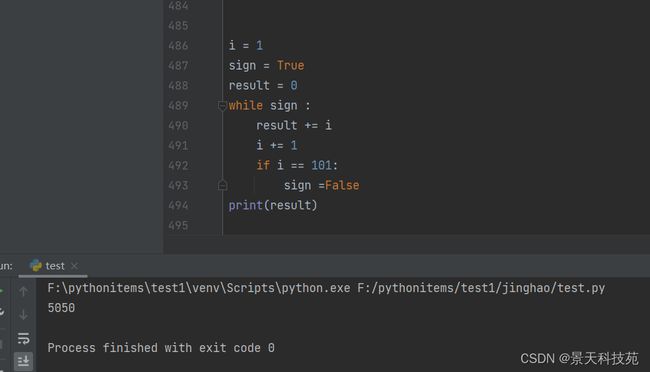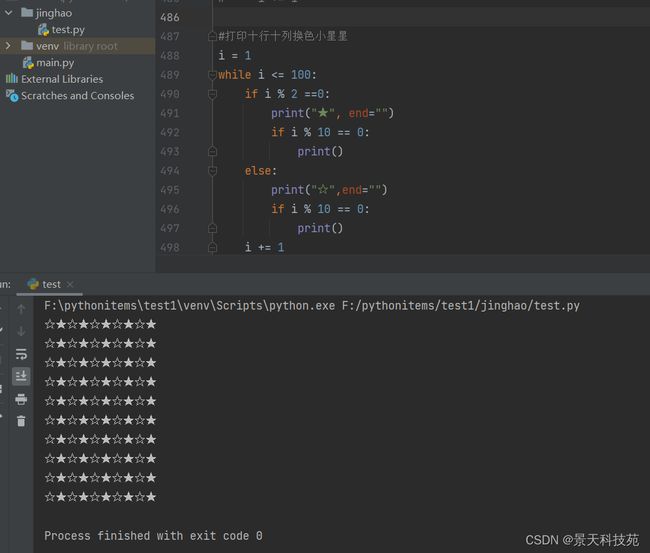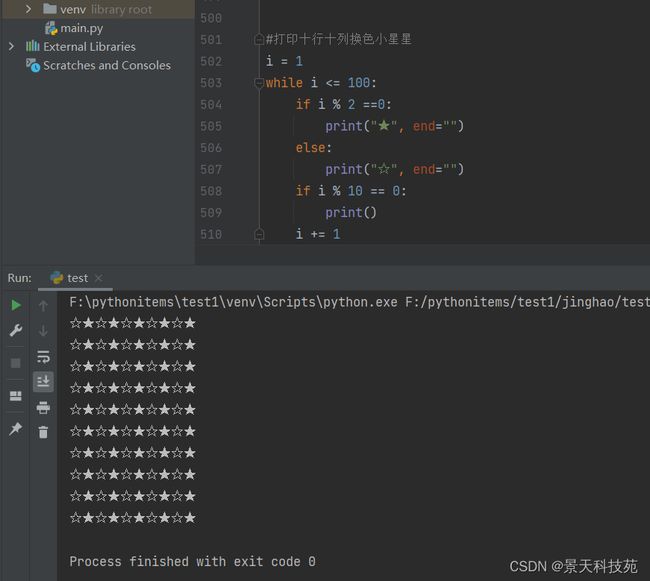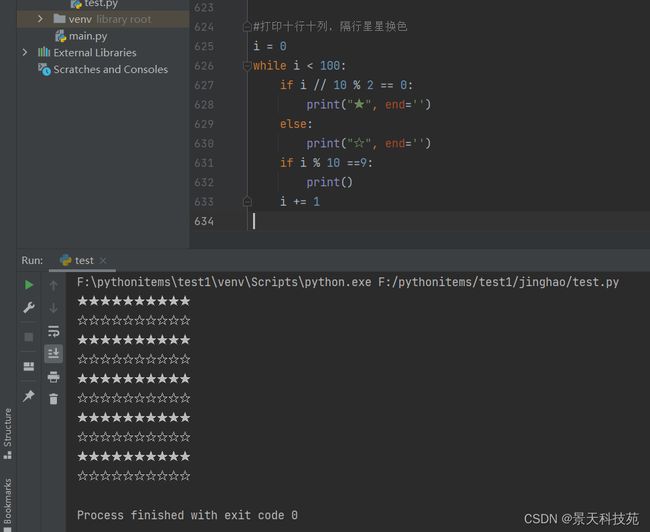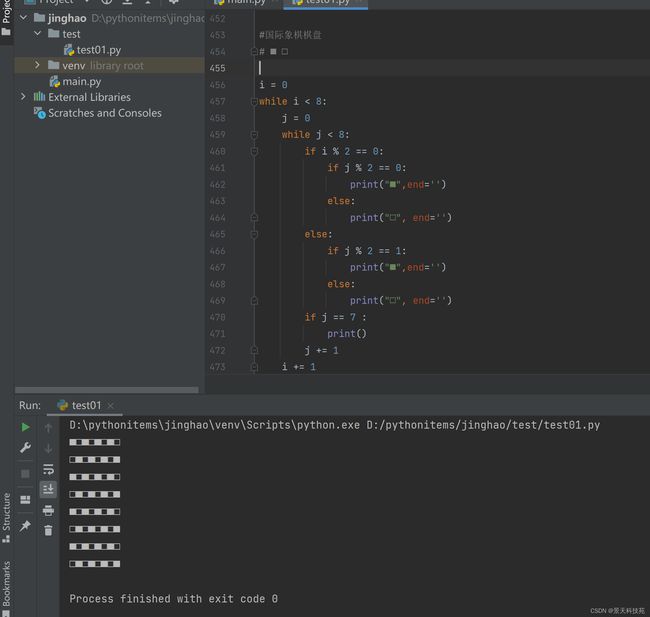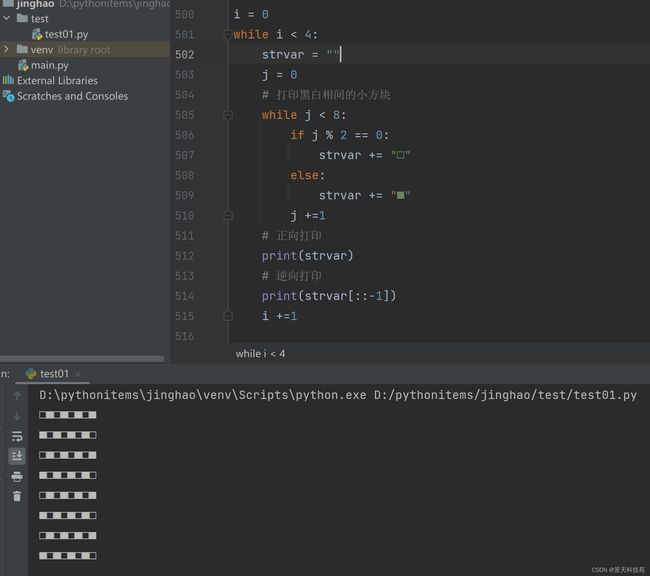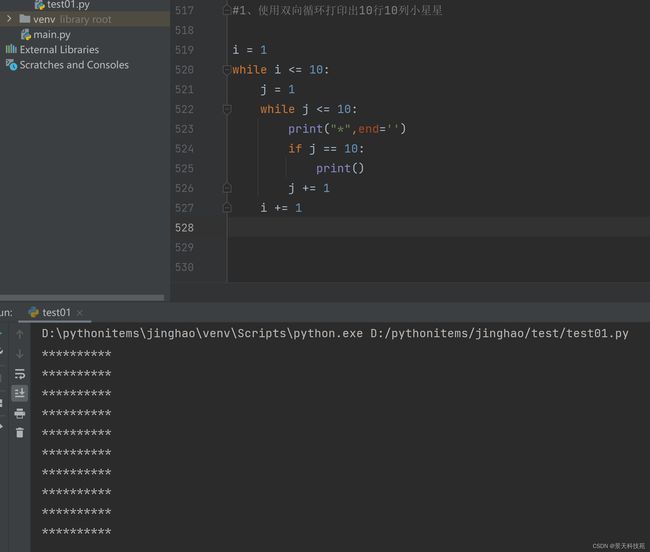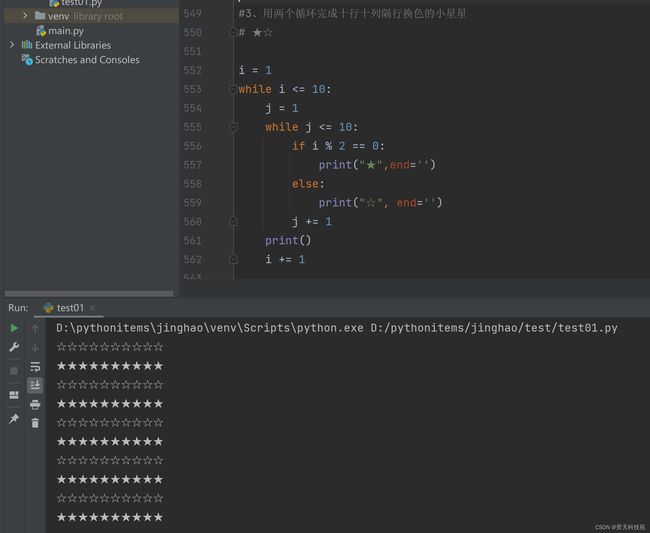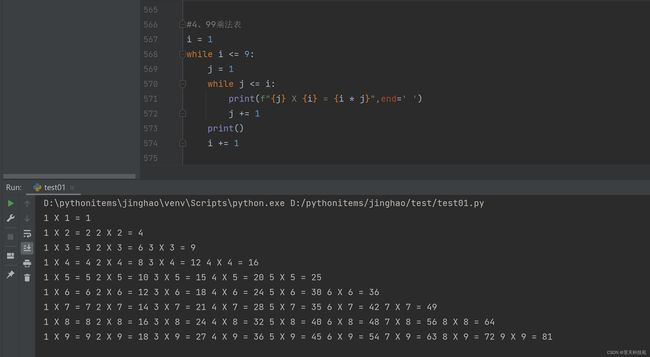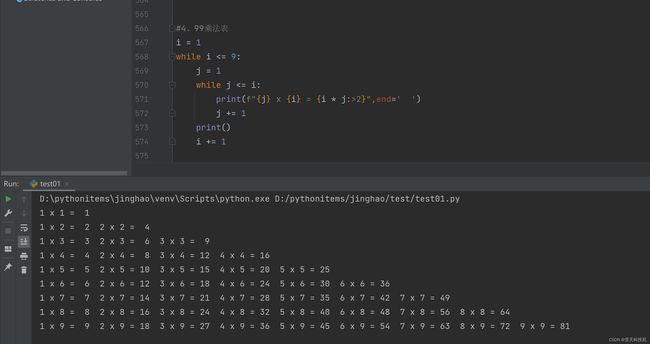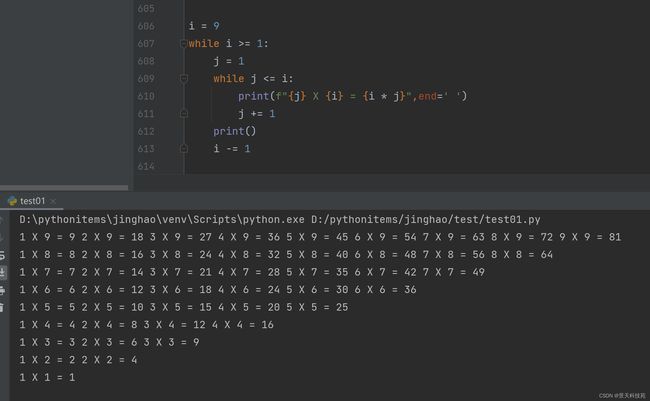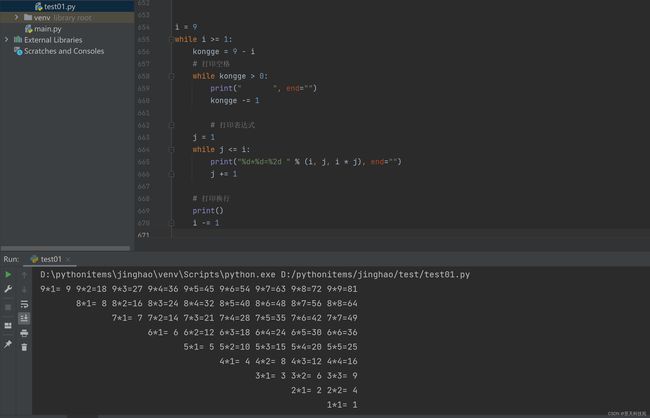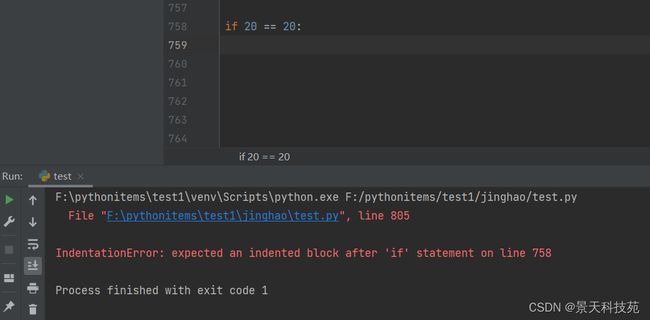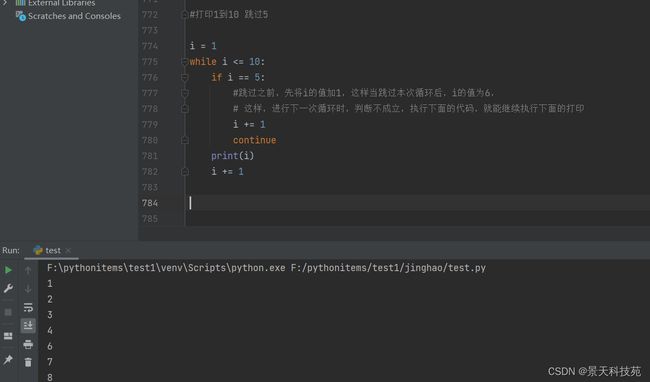Python中的while循环,知其然知其所以然
文章目录
- while循环结构
-
- 1.用循环打印1 ~ 100步骤解析
- 2. 1 ~ 100的累加和
- 3.死循环
-
- 1. 用死循环的方法实现 1 ~ 100累加和
- 4. 单向循环
-
- (1)打印 一行十个小星星*
- (2)通过打印一个变量的形式,展现一行十个小星星
- (3)一行十个换色的星星 ★☆★☆★☆★☆★☆
- (4)用一个循环,打印十行十列小星星
- (5) 一个循环实现十行十列,格列换色的小星星
- (6)一个循环实现十行十列,隔行换色的小星星
- (7)国际象棋棋盘
- 5.双向循环
-
- 1.用两个循环完成十行十列的小星星
- 2.用两个循环完成十行十列隔列换色的小星星
- 3.用两个循环完成十行十列隔行换色的小星星
- 4.使用循环打印99乘法表
-
- 方向一
- 方向二
- 方向三
- 方向四
- 6.求吉利数字 100 ~ 999 之间 找 111 222 333 123 456 654 321 ...
-
- 方法一
- 方法二
- 方法三
- 7.百钱买百鸡
- 8.break continue pass 关键字的使用
-
- (1)pass 过 (代码块中的占位符),防止代码报错,没有逻辑意义
- (2)break 终止当前循环 (只能用在循环之中)
- (3)continue 跳过当前循环,从下一次循环开始,跳过后,continue后面的代码是不执行的
while循环结构
Python中的while循环是一个重复执行某段代码块的条件控制语句,只要条件为真,就会一直执行下去,直到条件不再满足为止。
特点:减少冗余代码,提升执行效率
语法:
while 条件表达式:
code1
(1) 初始化一个变量
(2) 写上循环的条件
(3) 自增自减的值
1.用循环打印1 ~ 100步骤解析
#(1) 初始化一个变量
i = 1
#(2) 写上循环的条件
while i <= 100:
# (4) 写上循环的逻辑
print(i)
# (3) 自增自减的值
i += 1 # i = i + 1
代码解析:
第一次循环
i = 1 i<=100 判断为真,执行循环体 print(1)
i += 1 i => 2
第二次循环
代码回到17行,重新进行条件判定
i = 2 i<=100 判断为真,执行循环体 print(2)
i += 1 i => 3
第三次循环
代码回到17行,重新进行条件判定
i = 3 i<=100 判断为真,执行循环体 print(3)
i += 1 i => 4
…
以此类推
直到i = 101 i <= 100 判断为假,不执行循环体,到此循环结束…
1 ~ 100
2. 1 ~ 100的累加和
#(1) 初始化一个变量
i = 1
total = 0
#(2) 写上循环的条件
while i <= 100 :
# (4) 写上自定义的逻辑
total += i
# (3) 自增自减的值
i += 1
print(total)
代码解析:
第一次循环
i = 1 i <= 100 判定为真True 执行循环体 total += i => total = total + i => 0 + 1
i += 1 => i = 2
第二次循环
i = 2 i <= 100 判定为真True 执行循环体 total += i => total = total + i => 0 + 1 + 2
i += 1 => i = 3
第三次循环
i = 3 i <= 100 判定为真True 执行循环体 total += i => total = total + i => 0 + 1 + 2 + 3
i += 1 => i = 4
…
依次类推
当i = 101 101 <= 100 判定为假False 不执行循环体,到此,循环结束…
total += i => total + i => 0 + 1 + 2 + 3 + 4 + … + 100 => 5050
3.死循环
写程序的时候,除了特定要求,一定要避免死循环,否则将一直占用CPU
1. 用死循环的方法实现 1 ~ 100累加和
i = 1
total = 0
sign = True #设置个变量,是为了不使用关键字的情况下,控制能退出循环
while sign:
total += i
i+=1
# 判断i是否加到了101 , 不参与循环
if i == 101:
# 终止循环
sign = False
print(total) #1 ~ 100 = 5050
4. 单向循环
(1)打印 一行十个小星星*
help(print)
#help 查看某个方法的文档 相当于linux里面的 --help ,查看某函数(方法)的使用方法
help(print)
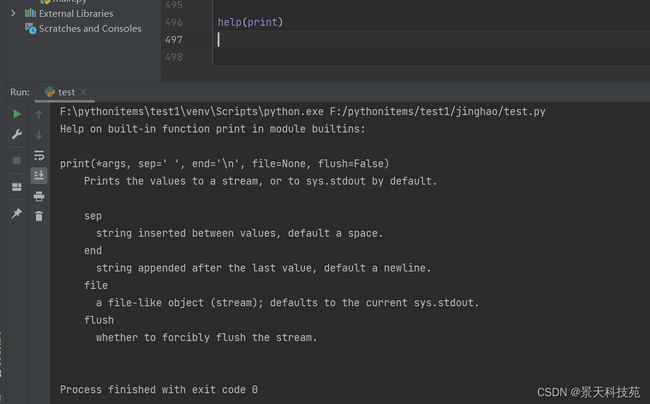
默认间隔是空格,默认结尾带换行,默认输出的是系统标准输出。可以修改

i = 0
while i<10:
# end='' 打印时,尾部默认不加换行
print("*",end='')
i += 1
# 默认换行
# print()
(2)通过打印一个变量的形式,展现一行十个小星星
i = 0
strvar = ""
while i < 10:
# 写上循环的逻辑
strvar += "*" # strvar = strvar + "*"
i +=1
print(strvar)
strvar += "*" => strvar = "*"
strvar += "*" => strvar = "*" + "*" = "**"
strvar += "*" => strvar = "**" + "*" = "***"
...
strvar += "*" => strvar = "********" + "*" = "*********"
(3)一行十个换色的星星 ★☆★☆★☆★☆★☆
#方法一
i = 0
while i < 5:
print(“★☆”,end=“”)
i+=1
#方法二
i = 0
while i < 10:
if i % 2 == 0 :
print(“★”,end=“”)
else:
print(“☆”,end=“”)
i+=1
print(“<=============>”)
#方法三
i = 0
strvar = “”
while i < 10:
if i % 2 == 0 :
strvar += “★”
else:
strvar += “☆”
i+=1
print(strvar)

公式: 任意数 和 n 进行取余,余数的范围: 0 ~ (n-1)
0 % 2 = 0
1 % 2 = 1
2 % 2 = 0
3 % 2 = 1
被除数 % 2 => 0 或者 1
0 % 5 = 0
1 % 5 = 1
2 % 5 = 2
3 % 5 = 3
4 % 5 = 4
5 % 5 = 0
6 % 5 = 1
7 % 5 = 2
被除数 % 5 => 0 或者 1,2,3,4
(4)用一个循环,打印十行十列小星星
“”"
★★★★★★★★★★
★★★★★★★★★★
★★★★★★★★★★
★★★★★★★★★★
★★★★★★★★★★
★★★★★★★★★★
★★★★★★★★★★
★★★★★★★★★★
★★★★★★★★★★
★★★★★★★★★★
“”"

#方法一
i = 0
while i < 100:
# 逻辑写在这里
print("*" , end="")
# 打印换行 (在9 19 29 .. 99 )
if i % 10 == 9:
print()
i += 1
0123456789
10111213141516171819
20212223242526272829
…
90919293949596979899
9 19 29 39 49 59 69 79 89 99 个位数都带9,与9取余为0时换行,即可
9 % 10 = 9
19 % 10 = 9
29 % 10 = 9
…
99 % 10 = 9
“”"
#方法二
i = 1
while i <= 100:
# 逻辑写在这里
print("*" , end="")
# 打印换行 (在10 20 30 .. 100 )
if i % 10 == 0:
print()
i += 1
12345678910
**********
11121314151617181920
**********
21222324252627282930
**********
...
919293949596979899100
**********
10 20 30 ... 100
(5) 一个循环实现十行十列,格列换色的小星星
★☆★☆★☆★☆★☆
★☆★☆★☆★☆★☆
★☆★☆★☆★☆★☆
★☆★☆★☆★☆★☆
★☆★☆★☆★☆★☆
★☆★☆★☆★☆★☆
★☆★☆★☆★☆★☆
★☆★☆★☆★☆★☆
★☆★☆★☆★☆★☆
★☆★☆★☆★☆★☆
i = 0
while i < 100:
# (1)打印星星
if i % 2 == 0 :
print("★",end="")
else:
print("☆",end="")
# (2)打印换行 (在9 19 29 .. 99 )
if i % 10 == 9:
print()
i += 1
(6)一个循环实现十行十列,隔行换色的小星星
★★★★★★★★★★
☆☆☆☆☆☆☆☆☆☆
★★★★★★★★★★
☆☆☆☆☆☆☆☆☆☆
★★★★★★★★★★
☆☆☆☆☆☆☆☆☆☆
★★★★★★★★★★
☆☆☆☆☆☆☆☆☆☆
★★★★★★★★★★
☆☆☆☆☆☆☆☆☆☆
公式:任意数和n进行地板除,会出现n个相同的数
0 // 10 = 0
1 // 10 = 0
2 // 10 = 0
…
9 // 10 = 0
0 ~ 9 // 10 => 0 (10个相同的0)
10 // 10 = 1
11 // 10 = 1
12 // 10 = 1
…
19 // 10 = 1
10 ~ 19 // 10 => 1 (10个相同的1)
… 以此类推
20 ~ 29 // 10 => 2 (10个相同的2)
30 ~ 39 // 10 => 3 (10个相同的3)
40 ~ 49 // 10 => 4 (10个相同的4)
…
90 ~ 99 // 10 => 9 (10个相同的9)
0~ 100 会出现10个相同的0,1,2 , 3 … 9
0 // 3 0
1 // 3 0
2 // 3 0
3 // 3 1
4 // 3 1
5 // 3 1
“”"
“”“”“”
#方法一
i = 0
while i < 100:
# (1)打印星星
if i // 10 % 2 == 0:
print("★",end="")
else:
print("☆",end="")
# (2)打印换行 (在9 19 29 .. 99 )
if i % 10 == 9:
print()
i += 1
#方法二
i = 10
while i < 110:
# 打印星星
num = int(str(i)[-2])
if num % 2 == 0 :
print("★",end="")
else:
print("☆",end="")
# 打印换行
if i % 10 == 9:
print()
i+=1
"""
10 ~ 100 101 102 103 110...
10 ~ 19 => 1
20 ~ 29 => 2
30 ~ 39 => 3
90 ~ 99 => 9
100 ~ 109 => 0
"""
国际象棋棋盘
(7)国际象棋棋盘
#■ □
i = 0
while i < 8:
j = 0
while j < 8:
if i % 2 == 0:
if j % 2 == 0:
print("■",end='')
else:
print("□", end='')
else:
if j % 2 == 1:
print("■",end='')
else:
print("□", end='')
if j == 7 :
print()
j += 1
i += 1
5.双向循环
1.用两个循环完成十行十列的小星星
j = 0
while j < 10:
# 打印星星
i = 0
while i < 10:
print("*",end="")
i+=1
# 打印换行
print()
j += 1
逻辑分析,双层循环,各做各的,内层循环是连续打印一行连续的10个星星,外层循环是将内层循环,循环执行十遍,然后内存循环一次,做次换行,就是这么无脑
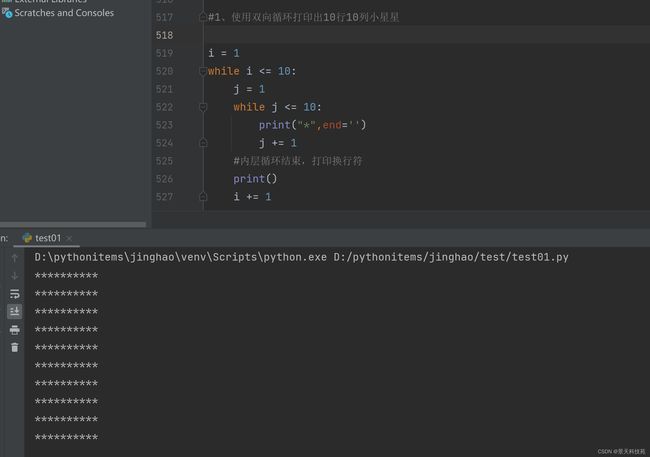
2.用两个循环完成十行十列隔列换色的小星星
“”"
☆★☆★☆★☆★☆★
☆★☆★☆★☆★☆★
☆★☆★☆★☆★☆★
☆★☆★☆★☆★☆★
☆★☆★☆★☆★☆★
☆★☆★☆★☆★☆★
☆★☆★☆★☆★☆★
☆★☆★☆★☆★☆★
☆★☆★☆★☆★☆★
☆★☆★☆★☆★☆★
“”"
i = 0
while i < 10:
# 打印一行黑白相间的星星
j = 0
while j < 10:
if j % 2 == 0:
print("☆",end="")
else:
print("★",end="")
j +=1
# 打印换行
print()
i+=1
3.用两个循环完成十行十列隔行换色的小星星
★★★★★★★★★★
☆☆☆☆☆☆☆☆☆☆
★★★★★★★★★★
☆☆☆☆☆☆☆☆☆☆
★★★★★★★★★★
☆☆☆☆☆☆☆☆☆☆
★★★★★★★★★★
☆☆☆☆☆☆☆☆☆☆
★★★★★★★★★★
☆☆☆☆☆☆☆☆☆☆
外层的循环i动的慢
内层的循环j动的快
外层的i动一次, 内层的循环动10次
i = 0
while i < 10 :
j = 0
while j < 10:
if i % 2 == 0:
print("☆",end="")
else:
print("★",end="")
j +=1
print()
i +=1
4.使用循环打印99乘法表
方向一
i = 1
while i <= 9:
# 打印对应的表达式
j = 1
while j <= i:
print("%d*%d=%2d " % (i,j,i*j) ,end="" )
j+=1
# 打印换行
print()
i +=1
方向二
i = 9
while i >= 1:
# 打印对应的表达式
j = 1
while j <= i:
print("%d*%d=%2d " % (i,j,i*j) ,end="" )
j+=1
# 打印换行
print()
i -= 1
方向三
i = 1
while i <= 9 :
kongge = 9 - i
# 打印空格
while kongge > 0:
print(" ",end="")
kongge -= 1
# 打印表达式
j = 1
while j <= i:
print("%d*%d=%2d " % (i,j,i*j) ,end="" )
j+=1
# 换行
print()
i +=1
原理:如图3, 1x1被空格挤到了右边,每个表达式f"{j} x {i}={i*j:>2}",end=’ ’ 占了9位,即9个空格。最多的一行从1x1到1x9 一共占了 9组,9x9 =81个空格,但有个1x1一组,空格最多一行占八组空格
所以空格组数,从8到 1依次递减,直到最后一行,空格数为零,不再需要空格去占位。跟之前的1x1到1x9打印方式一样
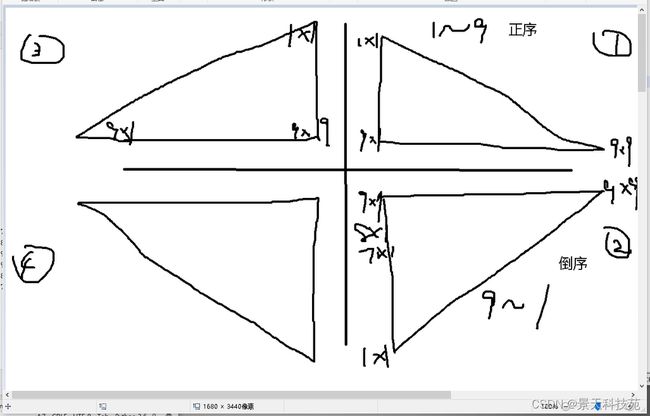
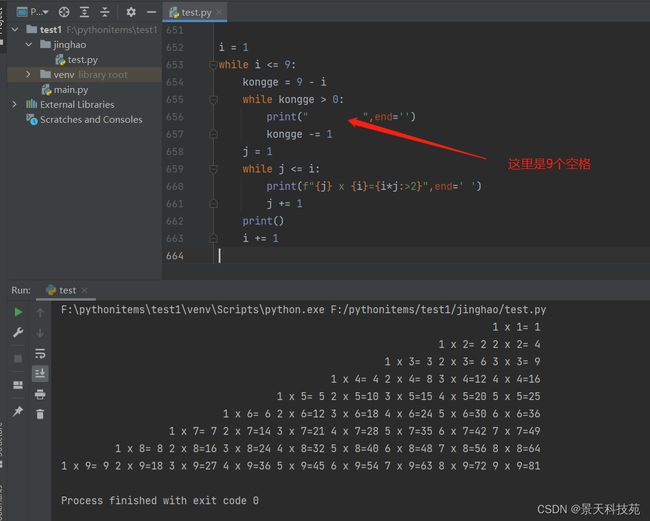
一组有多少个空格,空格循环那里打印几个空格
即每个表达式f"{j} x {i}={i*j:>2}",end=’ ’ 占了9位,即9个空格
方向四
i = 9
while i >= 1 :
kongge = 9 - i
# 打印空格
while kongge > 0:
print(" ",end="")
kongge -= 1
# 打印表达式
j = 1
while j <= i:
print("%d*%d=%2d " % (i,j,i*j) ,end="" )
j+=1
# 打印换行
print()
i -=1
6.求吉利数字 100 ~ 999 之间 找 111 222 333 123 456 654 321 …
// 可以获取一个数高位
% 可以获取一个数低位
baiwei = 345 // 100
shiwei = 345 // 10 % 10
gewei = 345 % 10
print(gewei)
方法一
i = 100
while i <= 999:
baiwei = i // 100
shiwei = i // 10 % 10
gewei = i % 10
if shiwei == gewei and shiwei == baiwei :
print(i)
# 123
elif shiwei == gewei - 1 and shiwei == baiwei + 1:
print(i)
# 987
elif shiwei == gewei + 1 and shiwei == baiwei - 1:
print(i)
i +=1
方法二
i = 100
while i <= 999:
strvar = str(i)
# print(strvar, type(strvar))
gewei = int(strvar[-1])
shiwei = int(strvar[1])
baiwei = int(strvar[0])
if shiwei == gewei and shiwei == baiwei :
print(i)
# 123
elif shiwei == gewei - 1 and shiwei == baiwei + 1:
print(i)
# 987
elif shiwei == gewei + 1 and shiwei == baiwei - 1:
print(i)
i +=1
方法三
i = 100
while i <= 999:
strvar = str(i)
# print(strvar, type(strvar))
gewei = int(strvar[-1])
shiwei = int(strvar[1])
baiwei = int(strvar[0])
if 2 * shiwei == gewei + baiwei and (shiwei == gewei + 1 or shiwei == gewei -1 ):
print(i)
elif gewei == shiwei and shiwei == baiwei:
print(i)
i +=1
7.百钱买百鸡
#公鸡一个五块钱,母鸡一个三块钱,小鸡三个一块钱,现在要用一百块钱买一百只鸡,问公鸡、母鸡、小鸡各多少只?
穷举法:把数据拿出来一个一个试
x = [1,2]
y = [3,4]
z = [5,6]
x+y+z = 10
1 + 3 + 5 = 9
1 + 3 + 6 = 10 bingo
1 + 4 + 5 = 10 bingo
1 + 4 + 6 = 11
2 + 3 + 5 = 10 bingo
2 + 3 + 6 = 11
2 + 4 + 5 = 11
2 + 4 + 6 = 12
公鸡 : x 母鸡 : y 小鸡: z
鸡的数量:x + y + z = 100
鸡的价格:5 * x + 3 * y + 1/3*z = 100
x = 0
while x <= 20:
y = 0
while y <= 33:
z = 0
while z <= 100:
if x+y+z == 100 and 5*x + 3 * y + 1/3*z == 100 :
print(x,y,z)
z += 1
y +=1
x += 1
8.break continue pass 关键字的使用
####关键字的使用 pass break continue
break和continue的区别,break是跳出循环
continue则是跳出本次循环执行下一次循环
return 也会终止循环
(1)pass 过 (代码块中的占位符),防止代码报错,没有逻辑意义
if 20 == 20:
pass
while True:
pass
(2)break 终止当前循环 (只能用在循环之中)
break语句用于结束循环,若循环中使用了break语句,程序执行到break
语句时会结束循环;若循环嵌套使用了break语句,程序执行到break语句时会
结束本层循环。
#1 ~ 10 遇到5终止循环
i = 1
while i <= 10:
print(i)
if i == 5:
break
i +=1
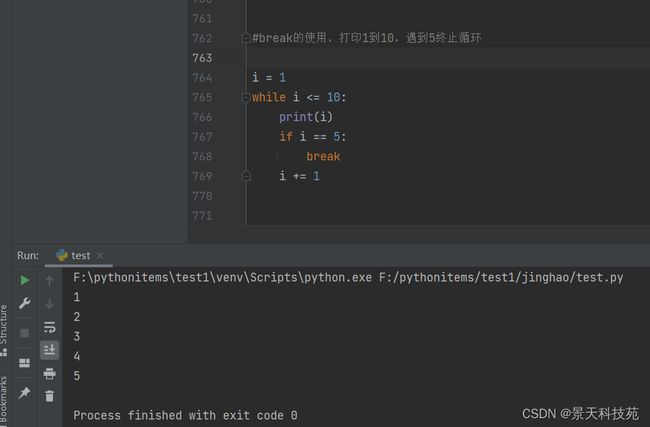
(3)continue 跳过当前循环,从下一次循环开始,跳过后,continue后面的代码是不执行的
#打印 1 ~ 10 跳过5
i = 1
while i <= 10:
if i == 5:
# 在跳过之前,因为会终止执行后面的代码,从下一次循环开始
# 为了避免死循环,手动加1
i += 1
continue
print(i)
i +=1
#1 ~ 100 打印所有不含有4的数字
#方法一
i = 1
while i <= 100:
strvar = str(i)
# print(strvar)
if "4" in strvar:
i += 1
continue
print(i)
i +=1
#方法二
i = 1
while i <= 100:
if i // 10 == 4 or i % 10 == 4:
i+=1
continue
print(i)
i+=1
总结:以上就是python关于while循环的所有用法,希望对大家在python的学习工作中有所帮助,ღ( ´・ᴗ・` )比心




